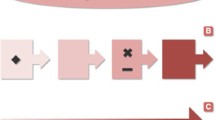Abstract
Through the use of principal components analysis of the correlation matrix between excentricity quotients of intra- and inter-individual transitions between pairs of the 22 most frequent behaviour elements of male and female gelada baboons observed in captivity, the total variance could be described in terms of a low number of causal factors. In intra-individual sequences the five factors requested of the analysis explain 74 per cent of the total variance. The following intra-individual groupings were found: (I) “autostimulation”, (II) “intensive social” versus “groom”, (III) “male sexual”, (IV) “attack” versus “sexual presentation”, and (V) “greeting” versus “threat”. In inter-individual transitions, the five factors explain 68 per cent of the variance. The following communicative sets were found: (1) “female-sexual releasing”, (2) “greeting and approaching releasing” versus “groom releasing”, (3) “austostimulation releasing” versus “male-sexual releasing”, (4) “fight releasing”, and (5) “conflict”. Mimetic induction of same acts or acts within one particular intra-individual set was frequent.
Similar content being viewed by others
References
Altmann, S. A., 1965. Sociobiology of rhesus monkeys. II. Stochastics of social communication.J. Theoret. Biol., 8: 490–522.
Alvarez, F., 1973. Periodic changes in the bare skin areas ofTheropithecus gelada.Primates, 14: 195–199.
---- &C. Consul de Alvarez, 1971. Communicación por posturas y expresiones faciales enTheropithecus gelada. ler. Cent. R. Soc. Española Ha. Nat., 23–43.
Bernstein, I. S., 1975. Activity patterns in a gelada monkey group.Folia primat., 23: 50–71.
Blurton Jones, N., 1972. Categories of child-child interaction. In:Ethological Studies of Child Behaviour,N. Blurton Jones (ed.), Cambridge University Press, London, pp. 97–127.
Bramblett, C. A., 1970. Coalitions among gelada baboons.Primates, 11: 327–333.
Carpenter, C. R., 1940. A field study of the behavior and social relations of the gibbon (Hylobates lar).Comp. Psychol. Monogr., 15: 1–212.
Crook, J. H., 1966. Gelada baboon herd structure and movement: A comparative report.Symp. zool. Soc. London, 18: 237–268.
Dunbar, R. I. M. &P. Dunbar, 1974. The reproductive cycle of the gelada baboon.Anim. Behav., 22: 203–210.
Emory, G. R., 1975a. Comparison of spatial and orientational relationships as manifestations of divergent modes of social organization in captive groups ofMandrillus sphinx andTheropithecus gelada.Folia primat., 24: 293–314.
————, 1975b. The pattern of interaction between the young males and group members in captive groups ofMandrillus sphinx andTheropithecus gelada.Primates, 16: 317–334.
Fedigan, L. M., 1972. Roles and activities of male geladas (Theropithecus gelada).Behaviour, 41: 82–90.
Goodall, J., 1965. Chimpanzees of the Gombe Stream Reserve. In:Primate Behavior,I. DeVore (ed.), Holt, Rinehart, & Winston, New York, pp. 425–473.
Hall, K. R. L. &I. DeVore, 1965. Baboon social behavior. In:Primate Behavior,I. DeVore (ed.), Holt, Rinehart, & Winston, New York, pp. 53–110.
Hazlett, B. A. &W. H. Bossert, 1965. A statistical analysis of the aggressive communications systems of some hermit crabs.Anim. Behav., 13: 357–373.
Jolly, A., 1972.The Evolution of Primate Behavior. Collier-MacMillan, London.
Koford, C. B., 1963. Group relations in an island colony of rhesus monkeys. In:Primate Social Behavior,C. H. Southwick (ed.), D. Van Nostrand, N. J., pp. 136–152.
Kummer, H., 1971.Primate Societies. Aldine Publishing Co., Chicago.
————, 1974. Distribution of interindividual distances in patas monkeys and gelada baboons.Folia primat., 21: 153–160.
Marler, P., 1965. Communication in monkeys and apes. In:Primate Behavior,I. DeVore (ed.), Holt, Rinehart, & Winston, New York, pp. 544–584.
Maslow, A. H., 1936. The role of dominance in the social and sexual behavior of infrahuman primates. III: A theory of the sexual behavior of infrahuman primates.J. Genet. Psychol., 48: 310–338.
Matthews, L. H., 1956. The sexual skin of the gelada baboon (Theropithecus gelada).Trans. Zool. Soc. London, 28: 543–552.
Maurus, M. &H. Pruscha, 1973. Classification of social signals in squirrel monkeys by means of cluster analysis.Behaviour, 47: 106–128.
Osman Hill, W. C., 1969. On the muscles of expression in the geladaTheropithecus gelada (Rüppell) (Primates, Cercopithecidae).Z. Morph. Tiere, 65: 274–286.
Poirier, F. E., 1974. Colobine aggression: A review. In:Primate Aggression, Territoriality, and Xenophobia,R. L. Holloway (ed.), Academic Press, New York, pp. 123–157.
Redican, W. K., 1975. Facial expressions in nonhuman primates. In:Primate Behavior: Developments in Field and Laboratory Research, Vol. 4,L. A. Rosenblum (ed.), Academic Press, New York, pp. 103–194.
Spivak, H., 1971. Ausdrucksformen und soziale Beziehungen in einer Dschelada-Gruppe (Theropithecus gelada) im Zoo.Z. Tierpsychol., 28: 279–296.
Terry, R. L., 1970. Primate grooming as a tension reducing mechanism.J. Psychol., 76: 129–136.
van Hooff, J. A. R. A. M., 1973. A structural analysis of the social behaviour of a semicaptive group of chimpanzees. In:Social Communication and Movement,M. von Cranach &I. Vine (eds.), Academic Press, London, pp. 75–162.
Washburn, S. L. & I. DeVore, 1963. The social life of baboons. In:Primate Social Behavior,C. H. Southwick (ed.),D. Van Nostrand, N.J., pp. 98–113.
Wiepkema, P. R., 1961. An ethological analysis of the reproductive behaviour of the bitterling (Rhodeus amarus Bloch).Arch. Néerl. Zool., 14: 103–199.
Author information
Authors and Affiliations
About this article
Cite this article
Alvarez, F., Cónsul, C. The structure of social behaviour inTheropithecus gelada . Primates 19, 45–59 (1978). https://doi.org/10.1007/BF02373226
Received:
Accepted:
Issue Date:
DOI: https://doi.org/10.1007/BF02373226




